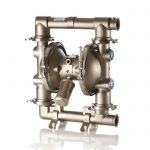In addition to being highly versatile and complete, pneumatic diaphragm pumps are very simple, from their installation to day-to-day use. They are powerful equipment that deliver great productivity, especially when compared to other positive displacement pump solutions.
Pneumatic diaphragm pumps can handle a wide range of materials and fluids and do not require electrical power to operate. Furthermore, they can run dry and are shear sensitive, which is a great advantage in handling fluids that can lose their properties when damaged. All this at an affordable initial purchase price and without the need for expensive, fancy controls.
As well as their use, the maintenance of these pumps is also considerably simple. However, to increase its useful life and ensure its proper functioning, it is very important to carry out preventive maintenance. This is possible through a few essential steps, such as:
Know your pump well
In general, pneumatic diaphragm pumps are fairly simple in composition, and knowing your equipment well can go a long way in creating an efficient maintenance schedule. This plan should include:
• Periodic examination of the diaphragm for possible wear (a stroke counter can help);
• Check pump hardware tightness to prevent leaks and locate damaged seals. Although very strong, the pump structure can eventually come loose due to continuous vibration and temperature changes.
Ensure a clean air supply
The pneumatic diaphragm pump only needs compressed air to work, but this air must be free of impurities. That's because the air distribution system is one of the most damaged parts of the pump. To help maintain air quality, you can install an air filter or regulator that can prevent debris from passing through and wet air from entering the pump.
Control the air supply
Air pressure can also negatively affect the performance of your pump diaphragm pneumatics. The operating speed is directly linked to the air pressure received, but it is useless to raise the flow above the pump's capacity. If it receives more pressure than it really needs, the pump will run too quickly and be inefficient.
To avoid this problem, having an air regulator can be the best solution. This tool helps ensure that the pump receives an adequate supply of air for its operation.
The fluid level controller can also help ensure proper pump operation, particularly in water and chemical reservoirs.
Inspect pump lines periodically
Since pneumatic diaphragm pumps can handle a wide range of fluids, they can be used in a variety of industries and applications. As versatile as the pump is, it is important to know that unforeseen events happen, especially in water treatment and in the mining industry.
Due to the flow of debris, it is common for larger solids to end up trapped and preventing proper flow from the pump. In this way, the constant inspection of the pump lines helps to identify possible blockages and maintain the proper functioning of the equipment.
Install a surge suppressor
This tool helps eliminate unwanted pulsation during pumping, as well as providing a virtually pulse-free discharge flow. With this, the pump can operate with a constant pressure, less vibration and noise, wearing less the piping system.
Identify and control leaks
Companies dealing with fluids, particularly hazardous waste, fear leaks more than any other type of technical problem. The whole operation can be interrupted, there is fluid spillage, there is risk of exposure, fines, and many other problems. Through a preventive maintenance protocol, leaks can be identified before they cause any kind of damage. In this case, in addition to the technical inspection, it is also possible to count on an electronic leak detector.










